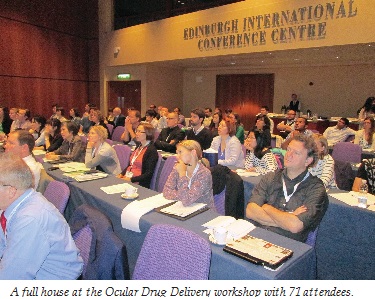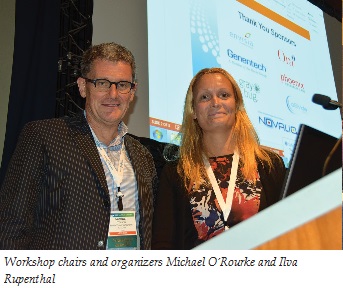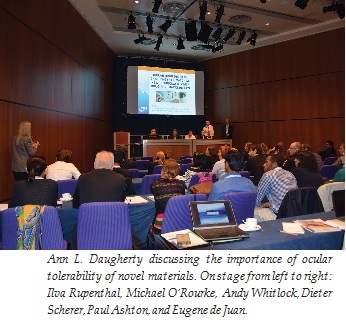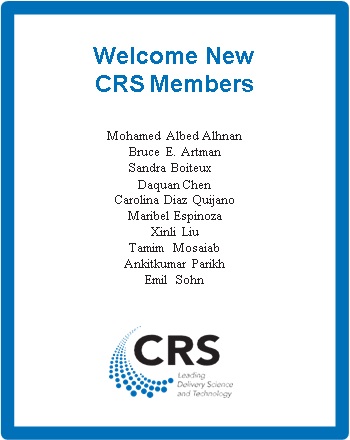Ocular Drug Delivery: Challenges of Matching New Technologies with Drug Pharmacokinetics
The 42nd CRS Annual Meeting & Exposition was held at the International Conference Centre, Edin burgh, Scotland, July 26– 29, 2015. Prior to the meeting, the premeeting Ocular Drug Delivery workshop, held on July 25, aimed at bringing together leading researchers from both academia and industry to share challenges and present recent approaches to deliver actives to the front as well as the back of the eye. Seventy-one attendees from academia and industry registered to listen to four speakers from academia and five from industry, as well as another four company presentations. The workshop was sponsored by Envisia Therapeutics, Novaliq GmbH, Genentech, Phoenix Research Labs, pSivida, GrayBug, and Ora.
burgh, Scotland, July 26– 29, 2015. Prior to the meeting, the premeeting Ocular Drug Delivery workshop, held on July 25, aimed at bringing together leading researchers from both academia and industry to share challenges and present recent approaches to deliver actives to the front as well as the back of the eye. Seventy-one attendees from academia and industry registered to listen to four speakers from academia and five from industry, as well as another four company presentations. The workshop was sponsored by Envisia Therapeutics, Novaliq GmbH, Genentech, Phoenix Research Labs, pSivida, GrayBug, and Ora.
The day started with a warm welcome by the chairs and organizers of the workshop, Ilva Rupenthal from the University of Auckland, New Zealand, and Michael O’Rourke from Scotia Vision Consultants, U.S.A. Ilva then kicked off the academic talks by providing a general overview of drug delivery approaches to the front and back of the eye, highlighting the limitations of current delivery technologies as well as the need to understand drug pharmacokinetics in order to accelerate the development process for emerging technologies. Arto Urtti from the University of Helsinki, Finland, then focussed on pharmacokinetic modelling and the limiting factors in developing predictive pharmacokinetic and pharmacodynamic models to evaluate ocular drug delivery approaches and follow the fate of the administered active.

Carrying on with the talks after a short morning tea break, Rocío Herrero-Vanrell from the Universidad de Complutense, Spain, presented on intraocular delivery of biodegradable microspheres to achieve sustained delivery of actives and thus reduce the frequency of administration, increasing patient compliance. Rocío covered recent publications from her group including the benefits of encapsulation into microspheres with a focus on additives used to further sustain delivery and enhance the stability of the actives. “Engineering Biomaterials for Ocular Applications” was the topic presented by Heather Sheardown from McMaster University, Canada, highlighting the progress of her group to use contact lenses as effective delivery devices for proteins and various other actives. She also presented on a smart implantable drug delivery system that can be activated by light, thus controlling the drug release non-invasively. Ann L. Daugherty, Senior Manager of Drug Delivery at Genentech Inc., U.S.A., was the first industry speaker and presented the challenges and successes of delivering protein therapeutics to the back of the eye. Focusing on various approaches to enhance efficient delivery of actives to the back of the eye by formulation, chemical modification, and device-based approaches, she urged scientists working in the field to consider aseptic compounding requirements and ocular tolerability of novel materials and devices at an early development stage.
After a delicious and well-earned lunch, the afternoon session kicked off with four company presentations. Stuart Williams from Envisia Therapeutics, U.S.A., talked about ENV515 and ENV905, two biodegradable devices based on the proprietary PRINT® technology that can provide sustained drug delivery over extended periods. This was followed by a talk from Dieter
 then talked about the preclinical development of ocular drug delivery technologies emphasizing the important factors to be considered for successful commercial development. Following that, Eugene de Juan from ForSight Labs, U.S.A., shared his experiences in the translation of an ocular drug delivery device from the laboratory to clinical trials, highlighting important considerations and discussing “what it actually takes.” The last presentation of the workshop entitled “The Complete Story— Going Through Regulatory Approval” was presented by Paul Ashton from pSivida Inc., U.S.A. Paul talked about his personal experience and involvement in the development of Vitrasert®, the first FDA-approved intravitreal device for sustained delivery of ganciclovir in the treatment of cytomegalovirus (CMV) infection. He also briefly described the most recently FDA- approved intravitreal device, Iluvien™, which is based on the Durasert™ technology and delivers sufficient amounts of drug over three years in the treatment of diabetic macular edema.
then talked about the preclinical development of ocular drug delivery technologies emphasizing the important factors to be considered for successful commercial development. Following that, Eugene de Juan from ForSight Labs, U.S.A., shared his experiences in the translation of an ocular drug delivery device from the laboratory to clinical trials, highlighting important considerations and discussing “what it actually takes.” The last presentation of the workshop entitled “The Complete Story— Going Through Regulatory Approval” was presented by Paul Ashton from pSivida Inc., U.S.A. Paul talked about his personal experience and involvement in the development of Vitrasert®, the first FDA-approved intravitreal device for sustained delivery of ganciclovir in the treatment of cytomegalovirus (CMV) infection. He also briefly described the most recently FDA- approved intravitreal device, Iluvien™, which is based on the Durasert™ technology and delivers sufficient amounts of drug over three years in the treatment of diabetic macular edema.
The meeting concluded with a panel discussion with all presenters gathering on stage and answering any questions related to their presentations. This triggered a constructive discussion, which was continued by speakers and workshop attendees over a glass of wine. Overall, the workshop was considered a great success, and we hope to offer similar events focussed on ocular drug delivery again in the near future. n

Scherer, Novaliq GmbH, Germany, who discussed their novel semifluorinated alkane technology, a non-aqueous vehicle that can improve formulation aspects and delivery of various actives. Dieter briefly touched on current products in the pipeline while highlighting the advantages of these novel vehicles to increase stability, solubility, and sterility of ocular formulations. Carrying on the company presentations, Scott Johnston from Phoenix Research Labs, U.S.A., presented on their Micron IV system designed to support eye research in laboratory animals. This retinal microscope produces high-quality digital fundus images of rodents and small animals for in vivo observations with capabilities in bright field, angiography, and fluorescent imaging. It can be acquired as a retinal imager alone or combined with optical coherence tomography, an image-guided laser for creating choroidal neovascularization (CNV), and/or with an image- guided focal electroretinogram (ERG) to measure retinal functionality. The final company presenter was Jeff Cleland, who presented on GrayBug’s proprietary poly(lactic-co-glycolic acid) (PLGA) technology that causes minimal inflammation when degraded in the eye compared with conventional PLGA. Jeff talked about the injectable formulations in the pipeline fabricated from this proprietary PLGA to achieve sustained drug delivery in the treatment of ocular conditions such as wet age-related macular degeneration (AMD), glaucoma, and corneal graft rejection.
“Market Dynamics and Overview of Recent Developments in Industry” was the topic presented by Michael O’Rourke. Michael briefly covered the history of intravitreal devices for sustained delivery of actives to the posterior segment of the eye. He also highlighted recent financial figures revealing the shift from the anterior to the posterior segment of the eye and touched on the cost of developing a novel active compared with that of improving the delivery of existing actives by novel delivery technologies, emphasizing the market shift toward such delivery technologies. Andy Whitlock from Ora Inc., U.S.A., an independent ophthalmic contract research organization (CRO),

